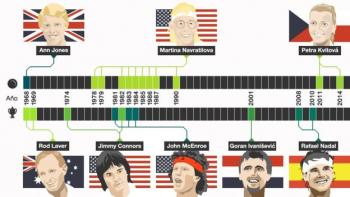

SPORT LEFT
03/06/2020
Why left-handers excel in some elite sports more than others
In baseball, 30% of top pitchers are left-handed.
If you are left-handed and want to excel in a sport, you have three to choose from: baseball, cricket and table tennis.
And is that, according to a study published in the journal Biology Letters, being left-handed is an important advantage when it comes to sports that require reacting very quickly.
This is possibly because, since most opponents are right-handed, they are not used to reacting quickly to unfamiliar movements made by the left-handed player.
"The information suggests that the more severe the time constraints are in a sport, the higher the proportion of left-handers (prominent)," explains Florian Loffing, a researcher at the University of Oldenburg in Germany and lead author of the study.
"We are less used to playing with left-handers, so we may not be developing optimal strategies to compete with them," he adds.
Fast reaction
Although between 10% and 13% of the population is left-handed, this proportion varies significantly in certain interactive sports. In some elite sports, for example, the left-handed quota is much higher.
To understand the reasons behind this difference, Loffing compiled a list of 100 of the best badminton, squash, tennis, table tennis, cricket, and baseball players (with information on whether they were left or right handed), between 2009 and 2014.
Image copyright Getty Images Image caption Nadal, who is left-handed only for tennis, takes advantage of that circumstance over mostly right-handed opponents
Analysis of this list revealed that over 30% of the best baseball pitchers were left-handed compared to 13% left-handed in badminton and 8.7% in squash players.
In female athletes, more than 19% in table tennis were left-handed, compared to 8% in tennis and badminton and 8.4% in squash.
In both tennis, squash and badminton, the reaction time to return the ball is relatively slower than in the other three sports where the left-handed quota is higher.
Practice
According to Loffing, the study gives more arguments to the idea that evolution did not lose the superior skill of the left hand since, in some areas it means an advantage.
A practical suggestion also emerges from the study.
To improve performance in fast reaction sports, what right-handers should do is train more with left-handed opponents to get used to better anticipating their movements.
In baseball, 30% of top pitchers are left-handed.
If you are left-handed and want to excel in a sport, you have three to choose from: baseball, cricket and table tennis.
And is that, according to a study published in the journal Biology Letters, being left-handed is an important advantage when it comes to sports that require reacting very quickly.
This is possibly because, since most opponents are right-handed, they are not used to reacting quickly to unfamiliar movements made by the left-handed player.
"The information suggests that the more severe the time constraints are in a sport, the higher the proportion of left-handers (prominent)," explains Florian Loffing, a researcher at the University of Oldenburg in Germany and lead author of the study.
"We are less used to playing with left-handers, so we may not be developing optimal strategies to compete with them," he adds.
Fast reaction
Although between 10% and 13% of the population is left-handed, this proportion varies significantly in certain interactive sports. In some elite sports, for example, the left-handed quota is much higher.
To understand the reasons behind this difference, Loffing compiled a list of 100 of the best badminton, squash, tennis, table tennis, cricket, and baseball players (with information on whether they were left or right handed), between 2009 and 2014.
Image copyright Getty Images Image caption Nadal, who is left-handed only for tennis, takes advantage of that circumstance over mostly right-handed opponents
Analysis of this list revealed that over 30% of the best baseball pitchers were left-handed compared to 13% left-handed in badminton and 8.7% in squash players.
In female athletes, more than 19% in table tennis were left-handed, compared to 8% in tennis and badminton and 8.4% in squash.
In both tennis, squash and badminton, the reaction time to return the ball is relatively slower than in the other three sports where the left-handed quota is higher.
Practice
According to Loffing, the study gives more arguments to the idea that evolution did not lose the superior skill of the left hand since, in some areas it means an advantage.
A practical suggestion also emerges from the study.
To improve performance in fast reaction sports, what right-handers should do is train more with left-handed opponents to get used to better anticipating their movements.















